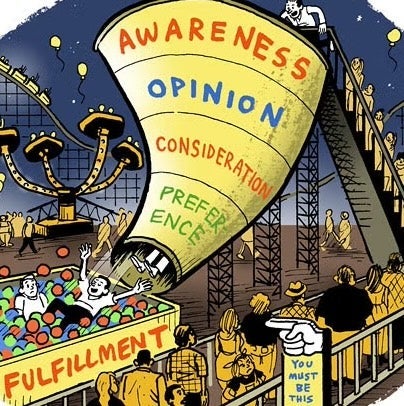At the end of last year I was asked to identify some trends that were most likely to stir up wild eddies in the 2006 consumer-marketing continuum. When you deal with customer loyalty metrics as we do, shifts in customer values always identify important changes that are coming down the road, usually 12-18 months before they show up on traditional research radar screens. So you can be pretty confident in your prognoses.
As these are predictive metrics, how marketers navigate these newly churned waters is always sure to determine the difference between success and failure. I mentioned five key trends, but one in particular resonated more than the others and was sure to have the most far-reaching effects: “consumer engagement.”
If you’re not tuned in to it now, you will be very soon. Defined as the outcome of advertising and marketing activities that substantively increases a brand’s strength in the eyes of the consumers (and if measured properly can actually predict sales and profitability), engagement is being used more and more to allocate marketing budgets. It has inserted itself between traditional marketing activities and an increasing demand for some kind (some might say any kind) of ROI assessments, At the very least people are talking about using engagement to make branding and creative decisions.
An initial examination and review by a task force spearheaded by the Advertising Research Foundation came to a critical conclusion: Traditional marketing and research had built advertising (and other) test systems on “accepted” models of how advertising worked. Well, it turned out that those models were asking and expecting consumers to think too much. In actuality people feel more than think.
Well, we agree wholeheartedly with that! Our company has maintained that since the dawn of the 21st century “bionic” consumer (which, on a standard calendar, was actually around 1985), the brand engagement process is 70% emotional and only 30% rational.
Yes, the Total Quality Management movement and process reengineering and a desperate need to “satisfy” customers from decades past, combined with the current technological advances in computers and cell phones and 24/7 access via the Internet to everything, have a lot to answer for! Most products and services are pretty much the same when it comes to meeting functional needs, and consumers don’t have to “rationally” think and compare and agonize about those product differences, because a) there weren’t all that many differences between category offerings (can you spell “commodity”?), and b) consumers were getting the information that they were using in the 30% of the rational decision process from places other than traditional marketing and advertising (who among you doesn’t have Google bookmarked on your computer?). So what does that leave but the emotional effects engendered–or owned–by a brand? Or the “emotional” advertising for a brand? Or the media for a brand that optimize a brand’s engagement opportunities?
Our studies have proven that if you can successfully identify, address, and communicate those emotional elements and values, you are virtually guaranteed to “engage” consumers. Certainly better than the competition relying on a presentation of rational facts, no matter how creatively shrouded they are. And don’t even think about expanding your media options as a “solution.” Today brand managers and marketers are more concerned with engaging customers than with finding them. Finding them stopped being a problem a long time ago.
The difficulty is, of course, that acknowledging the need to engage customers and actually measuring real customer engagement are two entirely different things. Most of the time there is no clear understanding of the emotional elements beyond the traditional, tried-and-true images and themes. (Memo to those marketing to baby boomers: 1960s rock music can only go so far.)
Real “engagement” is the consequence of any marketing or communication program that yields an increased level of brand equity for your product. When we say “brand equity” we mean the degree to which a brand is perceived as meeting or exceeding consumer expectations for the category in which it competes. Most of the time most of those “expectations” are emotionally based. And unconstrained by reality. Consumers want what they want, and they want it now!
Doubt me? In the past eight years, consumer category expectations have risen on average 27%, while brands have kept up only by 8%. That leaves an awfully big gap for you—or your competitor–to engage the consumer. If you measure it properly. And if you deliver it in a way that emotionally resonates with your audience and the brand.
Jim Stengel, the oft-quoted Procter & Gamble global marketing officer, said, “Without the right measurement, we really don’t know how well our efforts work. We don’t know if we are in touch with our consumers. We cannot continue to apply traditional thinking to the new world of technology and marketing channels available to us today.”
Engaging man, that Jim! Robert Passikoff, Ph.D., president of New York-based marketing firm Brand Keys (www.brandkeys.com).
 Network
Network



